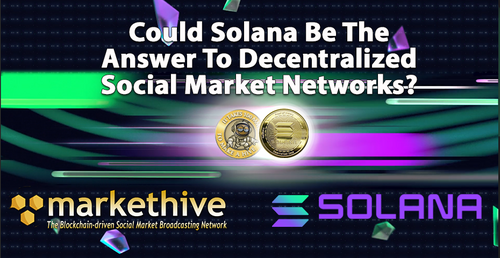
Could Solana Be The Answer To Decentralized Social Market Networks?
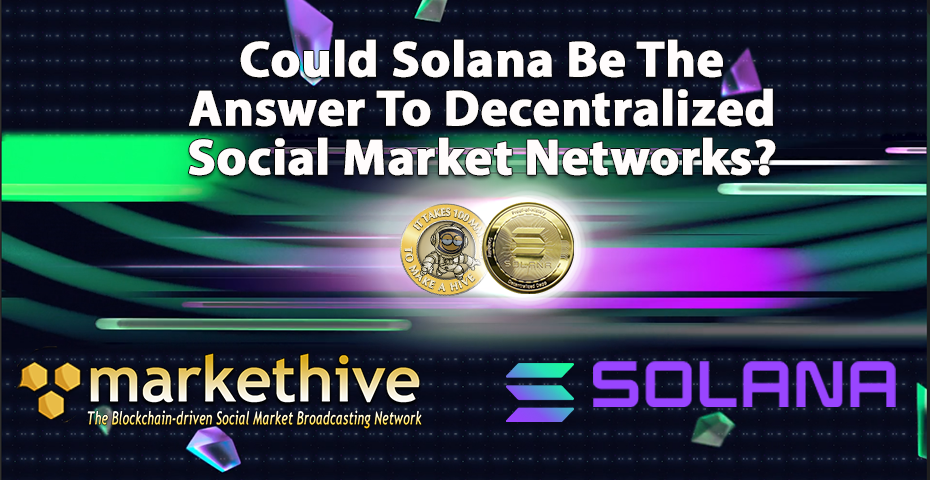
The Genisis Of The Blockchain Concept
The Blockchain concept was brought to light over 30 years ago by Stuart Haber and W. Scott Stornetta. They worked at Bell Communications Research (Bellcore), specializing in Telecoms research and development. As research scientists, they wrote a series of papers on cryptography, focusing on timestamping digital documents, and ended up creating a distributed immutable ledger. Some of their published materials and concept were adopted heavily by Satoshi Nakamoto in the 2008 Bitcoin whitepaper.

Image courtesy of Coingeeks Stuart Haber and W.Scott Stornetta
Haber and Stornetta were very influential and foundational in the development of the Blockchain we know today; however, almost every cryptocurrency blockchain today records transactions without reference to time. It took a few years, but someone eventually noticed that nobody was effectively keeping time in crypto and decided to do something about it.
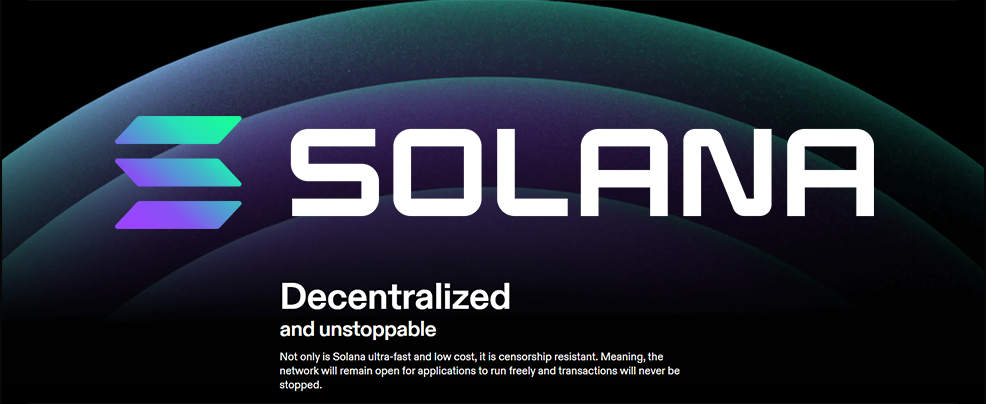
Image components sourced @ https://solana.com/ Adapted by Markethive.com
So What Makes Solana Tick?
Solana is the first blockchain crypto ecosystem to implement a timestamp mechanism by building a decentralized clock into its own native blockchain. Why is this important? Because Solana proves that it’s possible to be decentralized, secure, and scalable and shows that this can be done without using any layer two solutions like Ethereum 2.0’s Sharding protocol or Bitcoin’s Lightning Network.
Solana is named after a beach slightly North of San Diego, in the US, where Solana cryptocurrency founder Anatoly Yakovenko worked for nearly 13 years as a software engineer at Qualcomm and was instrumental in developing the technology used in Andriod phones. Qualcomm is a Fortune 500 company specializing in software, hardware, and wireless technologies for mobile phones.
Initially, Anatoly was not a very big fan of cryptocurrency, and he wasn’t impressed with Bitcoin and was only slightly interested in Ethereum. That was until one strange night in 2017, with what he described as a “caffeine-induced fever dream,” Anatoly figured out how to improve cryptocurrency blockchains by time-stamping transactions. The analogy Anatoly uses to explain this process will help you understand how.
Anatoly Yakovenko’s Analogy
In time past, if two radio towers sent out a signal on the same frequency simultaneously, those signals would collide, and the result would be white noise. So, to combat this, radio towers began operating on a time schedule.
For example, the first radio tower would send out a signal on the 1st second, and the second radio tower would send out a signal on the 2nd second. Then the first tower would send out a signal again and so on. Cryptocurrency blockchains, such as Bitcoin, are currently operating like those old radio towers.
Sometimes, two different miners will produce a new Bitcoin block at the same time. The blockchain splits, and the longest of the two blockchains wins. Whichever of the two new chains produces a block first becomes the actual Bitcoin blockchain. The other one gets ditched by Bitcoin Miners, and all transactions on that chain get shafted.
This is where the terminology, “the longest chain,” comes in and is used for this temporary situation where you have two blockchains. As with the radio towers, this inefficiency could be fixed if everyone on the Bitcoin network worked in sync with a clock where each transaction could be timestamped.
While companies such as Google and Intel can timestamp data using a regular clock in their centralized servers, building a decentralized clock is not easy. Who would be the timekeeper on a decentralized blockchain? And what would happen if two or more parties had different timestamps for the same transaction?
Anatoly figured out that the same SHA256 mining algorithm used by Bitcoin could be tweaked to function as a decentralized clock. Combining this with an optimized proof of stake consensus would make it possible to process an insane amount of transactions per second while maintaining network security and decentralization.
Solana. Unique Technology In Current Blockchain Systems
So in November of 2017, Solana was born with the release of the Solana platform testnet in February 2018. The core Solana innovation is Proof of History (POH), a globally-available, permissionless source of time in the network that works before consensus. POH is not a consensus protocol or anti-Sybil mechanism but a solution to the clock problem.
Solana uses the Proof of Stake consensus mechanism to validate transactions, with Proof of History incorporated, and is a critical component of the proof of stake consensus. This protocol is a verifiable delay function that is repetitively outputted by the SHA256 algorithm.
This repetitive output functions as the ticking of Solana’s decentralized clock, which is used to timestamp transactions. Validator nodes take turns performing tasks on the Solana blockchain, including producing blocks.
Proof Of History Explained
The Solano Foundation is a non-profit organization based in Geneva, Switzerland, and maintains the open-source project. Solana's scalability ensures transactions remain less than $0.01 for both developers and users.
Solana is all about speed, with 400 millisecond block times, and as hardware gets faster, so does the network. Solana is also censorship-resistant, meaning the network will remain open for applications to run freely and will never stop transactions.
Time Is Money In Your Pocket
The Solana project is highly complicated. So complicated that even crypto veterans hosting the Epicenter podcast had trouble wrapping their heads around it when they interviewed Anatoly.
At a glance, Solana is a high-performance Layer 1 Proof of Stake Blockchain. This means it does not need to use additional layer 2 Chains or solutions to handle transactions. Solana can process 50k to 65k transactions per second, making it the fastest Layer 1 cryptocurrency blockchain out there right now.
Like Ethereum, Solana is Smart contract compatible, meaning that developers can create new cryptocurrency tokens and decentralized applications on it. Solana already has over 250 projects and partners, including FTX, Tether USDT, USDC, Chainlink, BSN, and Serum.
At only 1000th of a cent to send a transaction, costing you just US$10 to send 1 million transactions on Solana’s blockchain, it’s no wonder many projects and applications are turning to the Solana ecosystem.
To put this in perspective, 1 million transactions on Ethereum today would cost you over US$300,000 worth of Eth, and that’s with the cheapest and slowest gas option possible. Solana's cheap transactions secret is in the POH and its verifiable delay function to the SHA256 mining algorithm, making it possible for all transactions to be timestamped.
This makes it possible for validator nodes on the network to organize transaction records after the fact without waiting for other validator nodes to check their records. On the Solana Blockchain, each new block produced is treated as a “tick” on this decentralized clock, and Solana’s clock ticks every 400 milliseconds.
The Secret To Fast Secure Transactions
So now we know how Solana organizes its data, but how can it generate so many transactions per second? A large part of this is due to Solana’s low barrier to entry to participate as a validator node on the network. To be a validator node on Solana, you need to stake their native SOL token. Here's the twist, though. There is no minimum stake required to be a validator node on Solana.
Compare this to the $70k you have to shell out to be a master node on Dash or the nearly $11k you need to become a validator node on Ethereum 2.0. Moreover, validator nodes on Solana fulfill all roles on the blockchain, and they are responsible for verifying transactions, storing transaction records, and generating new blocks.
For example, each validator node takes turns being the leader, which produces Solana blocks. Each turn lasts for four blocks, which is just 1.6 seconds, and the likelihood of being chosen to be a leader is proportional to the amount of SOL tokens you have staked. The fact that leaders change every 1.6 seconds makes it hard for a single validator node or even a group of validators to collude, attack or corrupt the network.
According to Coingecko, Solana has a total supply of 508 Million SOL tokens and a circulating supply of 320 Million.
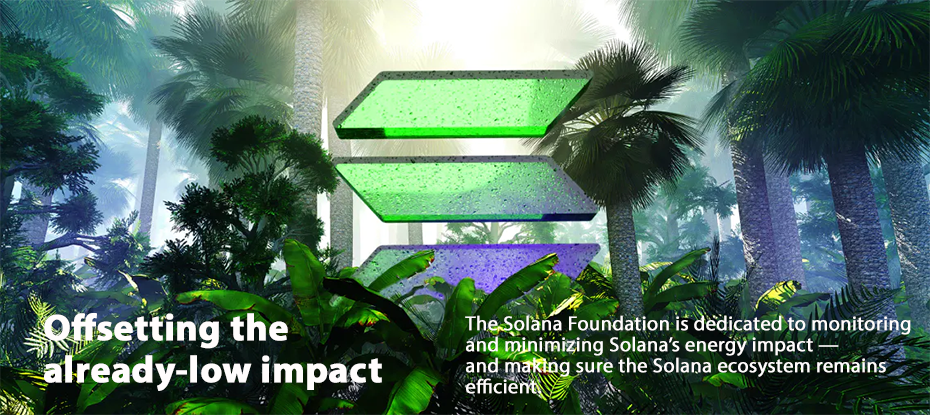
Image components sourced @ https://solana.com/environment Adapted by Markethive.com
How Does Solana’s Climate Footprint Compare?
Revealed in the Solana Climate Footprint Analysis, Solana is already highly energy efficient. The most recent analysis from the Solana Foundation estimates that a single Solana transaction uses only 1,939 Joules, which is less than the amount of energy required to complete two Google Searches. That is the equivalent of leaving an LED lightbulb on (36,000 J per hour) for a little more than 3 minutes or running your refrigerator (810,000 J per hour) for about 11 seconds.
It is also notably much less energy than transactions on other Blockchains, such as an Eth 2 transaction (126,000 J), an Ethereum transaction (777,600,000 J), or a Bitcoin transaction (7,412,400,000 J) as researched by Digiconomist. However, I have another recent report that analyzes Bitcoin’s carbon footprint contrary to what some headlines purport.
2021 – A Big Year For Solana
As mentioned in Solana’s community update, in January 2021, when Solana was less than a year old, it had 10 billion total transactions, $100 million total value locked, (TVL) 360 global validators, and 70 total projects.
By December 2021, those numbers had taken off: 45.5 billion transactions, $11.4 billion (TVL), 1,328 global validators, and 5,145 total projects in the ecosystem, plus more than 1 million NFTs minted, 5,985 total public repos, and many more highlights.
The Solana blockchain can already host something as demanding as the Serum DEX, and Tether”s integration with Solana, along with many other high-profile major projects, is also a massive vote of confidence for Solana.
This is all thanks to Solana’s unique design. Its Proof of History mechanism takes its Proof of Stake consensus mechanism to the next level by timestamping transactions. The low entry barrier to becoming a staking validator node on the network is a huge selling point.
Combine these two elements with the fact that the validator nodes frequently take turns producing blocks and fulfilling other roles on the Solana Blockchain, and you have a recipe for scalability, decentralization, and security for all types of projects.
The company had a humble beginning; it was not propped up by hundreds of millions of dollars of venture capital investors who wanted to turn a quick profit. It’s good to see that Solana does not appear to be heavily influenced by venture capital funding, which has been a significant issue for many other crypto projects.
It Takes A Special Blockchain To Cater To Social Media
Some blockchains have shied away from integrating social media platforms for several reasons. One is the amount of data and content generated on a platform, and many are not technologically able to cope with such a vast application or protocol.
Charles Hoskinson, CEO of Cardano, had an interesting conversation with SingularityNET CEO Ben Goertzel on decentralized social media. Although they are not ready for a platform like Markethive or even recognize it yet, they describe Markethive!
They speak of the dynamics and what’s needed to integrate a decentralized platform on a Blockchain. They analyze the shortcomings of Minds and Steemit, Facebook, and Twitter, stating that incentives are crucial, and it's always been an incentives problem.
“If you show that in a free market system you can achieve great wealth, or at least the prospect of great wealth by building a system of a certain design, then you'll end up getting a lot of it. The incentives models being aligned so that people can actually make money and produce money and do useful things with the system.”
The solving of top-level control issues by introducing a decentralized, AI-guided rating and reputation system that is self-policing and fosters a healthy level of interaction. It would also create a breeding ground for positive, creative, and beneficial content in which people's minds are being nudged toward positive growth.
Charles stated,
“You have to solve all three of those with one protocol design and one incentives design. And if you do that, then it's going to be this massive beacon that will attract tons of people to come in and start working on an augmented system and evolve it.
And it doesn't matter if it starts very small. It'll go very viral and eventually get to that Tesla-style hockey stick when Tesla figured out the entire model. Plenty of battery-powered cars before, but their particular model was the one that everything came together and then it had exponential growth.”
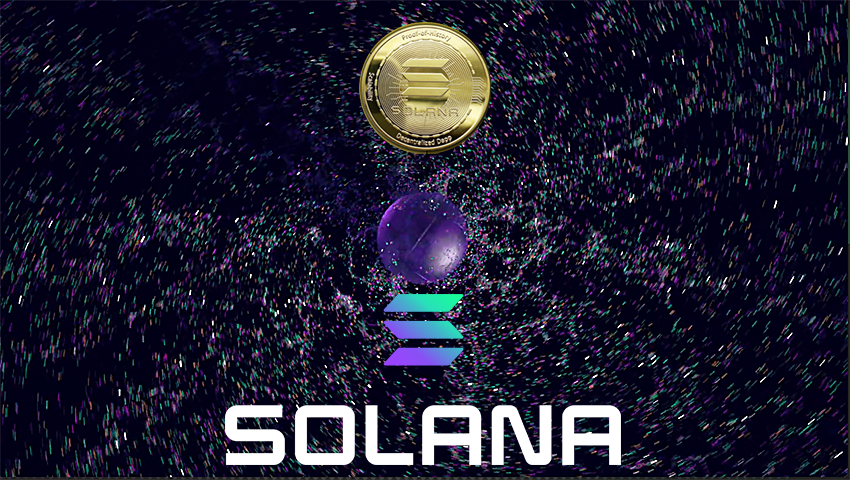
Image components sourced @ Solana.com. Adapted by Markethive.com
Solana – Social Media’s Blockchain
Because of Solana’s POH method, it can horizontally scale the rest of the blockchain, the same way that operating systems and databases scale their software. Each Solana team member has over a decade of experience working in operating systems GPU acceleration. Compilers, networks, etc., giving them extensive and deep experience optimizing software.
Solana is based on scaling software with hardware, with the vision of building the world's largest decentralized, single chart blockchain. The only way to do that is by scaling all the core technologies with hardware.
Scaling the Blockchain in this way delivers a cheap cryptographic base for financial transfers and, more importantly, outside of finance. It is a way for Solana to build a better web experience for social media communities regarding micropayments.
Also, advertising-based revenues can be relinquished for social networks, leading communities to generate value by self-expression, creating their own content, and growing the network and the connections within the community, creating a better world for all.
Listen to Anatoly Yakovenko, co-founder and architect of Solana, explain its submission to the Reddit Scaling Bake-Off.
Anatoly explains the team will work tirelessly to make sure that they can roll out the features Reddit wants for the entire 430 million Reddit user base. They aim to build the best possible experience for their communities to issue cryptocurrencies and have an open Smart contracts platform that is fully programmable.
Anatoly believes that technology can handle large crypto-based communities, and they’re just getting started. There is so much more to the Solana project. It’s all laid out in the Solana Documentation on its Website. https://docs.solana.com/introduction

Image by Markethive.com
Markethive – All Things To All People
Markethive is also working tirelessly to bring a beacon of light in these relentless dark times of the world. It is a monolithic project arming itself with complete autonomy on every level, rendering it impervious to the wicked tyranny that currently assails civilization globally.
There are various aspects of Markethive’s arsenal being forged simultaneously and will be ready for the millions seeking refuge and reclaiming their sovereignty. We now have our sovereign merchant account and preparing for our crypto wallet.
Solana and its technology look favorable as the conduit to assist in making Markethive the go-to for an alternative and autonomous, a censorship-free platform providing all components of social media, marketing, broadcasting, publishing, eCommerce, and business facilitation. A cottage industry economy for people from all walks of life to thrive.
Markethive also had a humble beginning and no prominent venture capitalists. It is built by the people, of and for the people. It is an ecosystem for entrepreneurs, and it’s the rank and file, the community that will profit, sharing the prosperity and abundance of every level of humanity.
Stay informed of Markethive’s progress as we make headway with the rollout of our new advanced system. A Divine fortress where evil cannot penetrate. Come to the weekly meetings every Sunday at 10 am Mountain Time, and you will find the invite link in the Markethive calendar.
This content is provided for informational purposes only and does not constitute investment advice.
Bruce Jacobs



